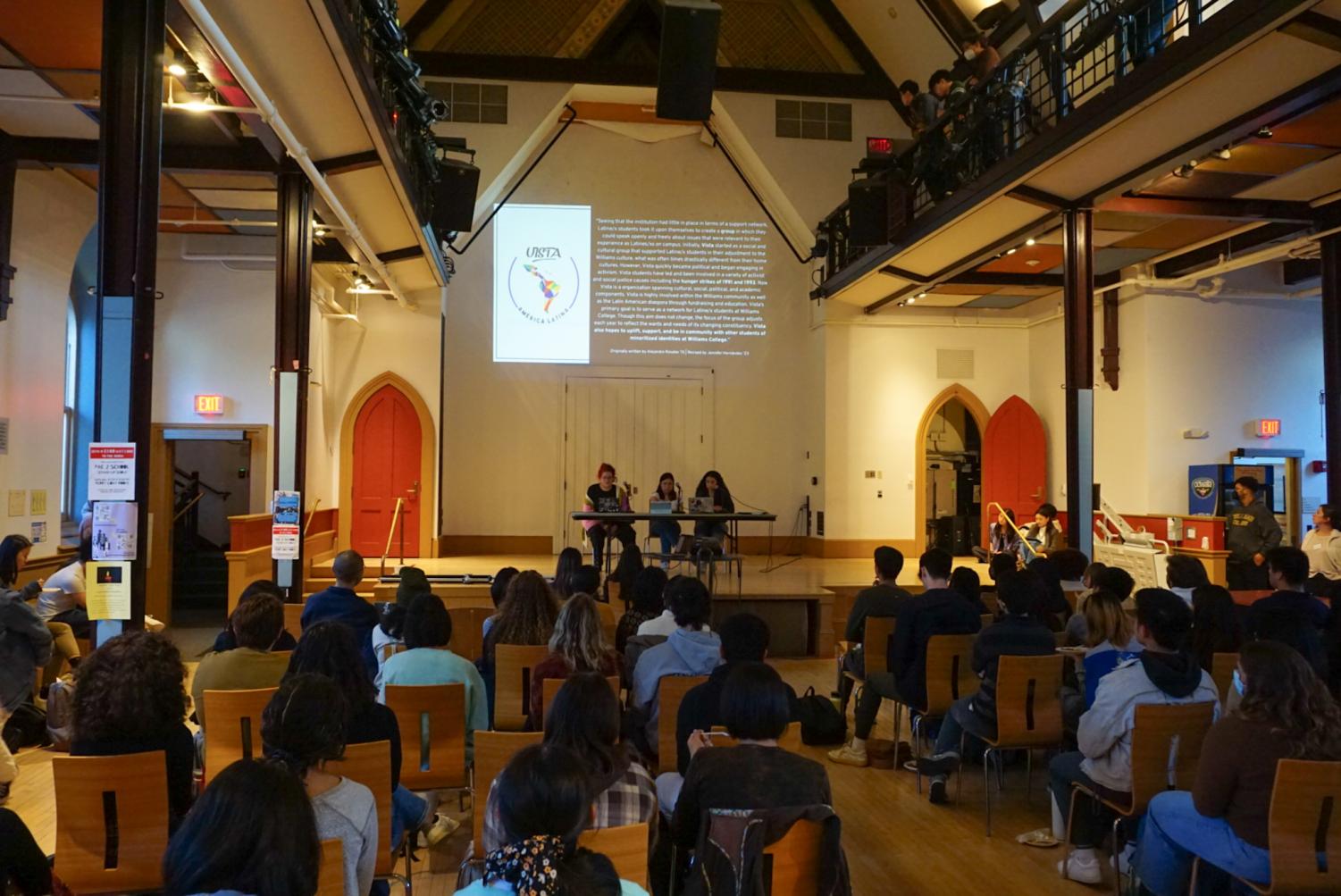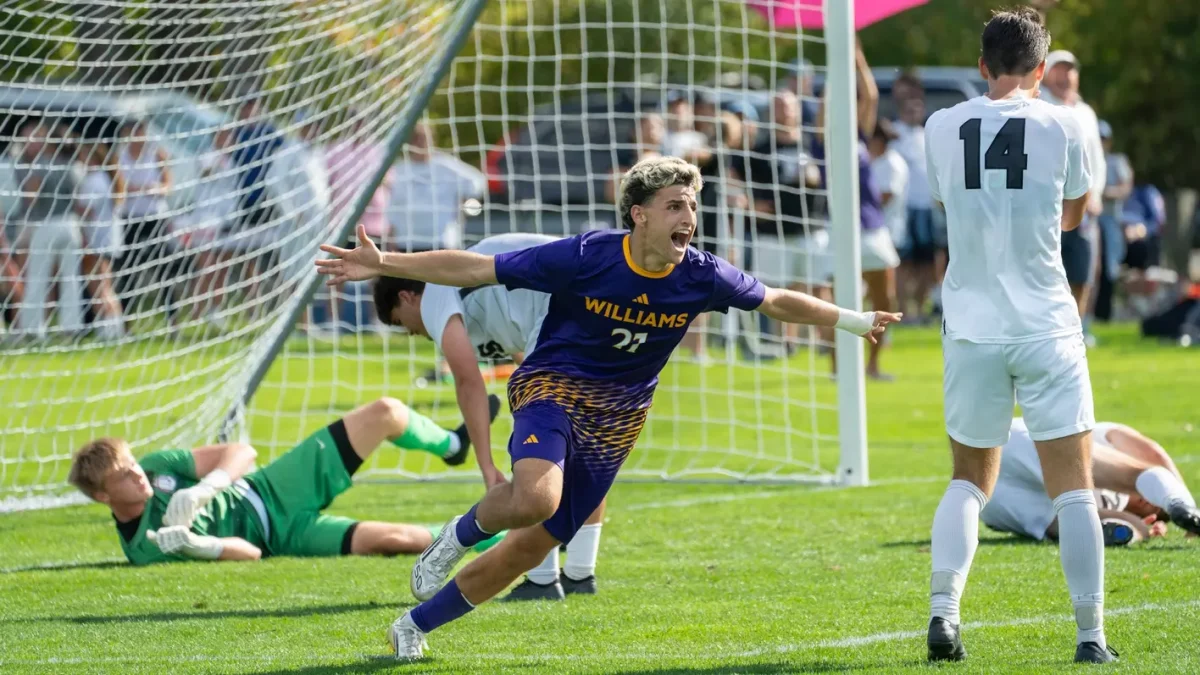AASiA, Vista, BSU host ethnic studies teach-in, affirm support for Asian American studies
September 28, 2022

Last Friday, more than 100 students packed Goodrich Hall as members of the Black Student Union (BSU); Vista, the College’s Latinx and Allies Student Organization; and Asian American Students in Action (AASiA) hosted an annual teach-in on the history and future of ethnic studies at the College.
The teach-in, which was held remotely the past two years, covered the history of the three affinity groups, the creation of the Africana studies and Latina/o studies concentrations, and advocacy for an Asian American studies (AAS) program. Each organization presented slides that highlighted the history of student movements for ethnic studies, talked about course offerings for this academic year, and articulated their club goals for this year and the future. The presentation began with a history of ethnic studies across the country, before focusing on the College.
BSU presented first, with Political Education Coordinator Kimberlean Donis ’23 noting the difficulties of learning about Black students’ experiences at the College. “I’ve realized during my time here, as a political science major and Africana studies concentrator, that no one really talks about the history of Black students at Williams, and more importantly, most people don’t know or don’t have the means to find the archives on these,” she said.
Donis, along with other BSU board members, gave an overview of past advocacy for Africana studies and the history of the Black student experience at the College. They covered topics such as the 1969 occupation of Hopkins Hall that led to the founding of the Afro-American studies program — a precursor to the current Africana studies concentration — and the subsequent hiring of the College’s first tenured Black faculty member Joseph E. Harris. They also discussed a 1980 cross-burning on campus and a 1988 occupation of the dean’s office by the Coalition Against Racist Education Now (CARE Now), which led to the creation of the Davis Center.
The BSU board members also argued that the College has struggled to retain Black faculty members in recent years. “The courses offered year to year tend to change as the faculty tends to change … which goes into the ongoing issue … [of] high faculty turnover,” BSU co-Chair Tyler Smith ’24 said. She attributed this to a number of factors, including the location of the campus and lack of support for faculty, in particular Black faculty.
A 2019 Record article interviewed several departing faculty members of color, some of whom said they felt the College created a hostile, isolating, and at times unsafe environment.
Smith noted the long-term effects of faculty of color departing the College. “This leads to students not really being able to form lasting relationships with some of these professors and some of them leaving … without students really having any transparency in that regard,” she said.
Vista’s presentation followed a similar format, noting the same 1988 occupation and a hunger strike in 1991, when students protested in an attempt to secure a tenure-track professor specializing in Latina/o studies. The group also explained the establishment of the Latina/o Studies department in 2004, noting the decades of student activism that preceded it and the department’s small size. “After more than 20 years of active struggle enacted by students on campus, we have the Latina/o studies department,” Vista Political Events Coordinator Annapurrna Xochisentli ’25 said. “However, after all of that, there are only three professors that are fully part of the faculty, which is incredibly sad and very disappointing.”
The AASiA board members began by outlining the 34- year long history of advocacy for an AAS program at the College, highlighting events such as the first proposal for the program in 2004 and the 2009 Faculty-Staff Initiative, which found that the College did not adequately support minority faculty. They also noted the 2012 External Review, which determined that the College did not have enough Asian Americanists and needed an AAS program, as well as the 2018 “Williams Doesn’t Teach Me” photo campaign and Jamboree disruption.
While BSU and Vista mentioned course offerings within the Africana studies department and the Latina/o studies department, respectively, AASiA noted that they felt they could not mention any course offerings at the teach-in due to the lack of an AAS department.
“We would love to be able to tell you about the course offerings that are happening in the spring like BSU and Vista have been able to, but we have no Asian American [studies] classes planned for the spring,” AASiA Events Manager Benet Ge ’25 said during the presentation. “The school has not committed to giving Asian American studies more resources until we exhibit a successful program. But how do we build a sustainable program without any resources?”
[Editor’s Note: Ge serves as an arts editor on the Record and was not involved in the writing or editing of this piece.]
Throughout the event, organizers highlighted the importance of coalition-building and mutual support across the three groups, as well as other clubs on campus.
Vista and BSU affirmed their strong support for the AAS movement and emphasized the importance of coming together in solidarity for it. “Williams expects this program to start slowly, but we have to have this department now,” Xochisentli said. “Not in 10 years, not even 15 years, we need this department now. We are all responsible for making sure that the next generation of students has the opportunity to learn [its] history and [its] identity without erasure… We will not stop organizing politically until the Asian American studies department is a reality.”
After each group’s presentation, leaders from all three organizations held a Q&A and gave closing remarks — some of which were geared towards the first-years in attendance.
“Even though you guys may not know the inner workings of your department, we are all sources for you, so utilize us… Just come up to us and ask us questions,” Donis said. “These departments wouldn’t exist if the students didn’t keep enrolling in these classes. So we want you to take interest and really show up and show out, and you guys did that today.”
Pauline Kang ’26 told the Record that she was drawn to the teach-in as an Asian American student interested in what classes were offered at the College. “I realized that … there was a lack of Asian American studies at Williams despite the continuous call for it during the past decades,” she said. “It was shocking to hear the struggles other ethnic groups, such as the Latinx and Africana groups, were facing too, and it was empowering to see everyone support each other in their individual calls for action.”
Attendees of the event noted that much of the information presented was new to them. “I went to the teach-in because I have taken a couple of Asian American studies courses which were really impactful and was curious why we don’t have a full-fledged department,” Keshini Cardozo ’24 said. “I learned a lot about the history of the Africana studies and Latina/o studies concentrations and found it shocking how much student resistance went into getting those departments established,” she said. “For a school that claims to be so committed to diversity and equity, students shouldn’t have to fight so hard to have classes that represent that diversity.”
After the event, key organizers from each group emphasized the role that the event plays in maintaining institutional history. “After the event, a lot of people came up to me and said they learned so much information that they didn’t have access to in the past,” Vista co-Chair Jennifer Hernandez ’23 said.
Group organizers emphasized the importance of access to archival history surrounding ethnic studies movements. “Even within our own MinCo groups, sometimes information is not always passed down,” co-Chair of AASiA Sunny Hu ’24 said. “I could definitely see faces of shock during some events we were talking about. I think it’s really important to have an ethnic studies teach-in yearly so that the new students and old students can all learn about this knowledge.”
Donis shared a similar sentiment, saying “everything that’s happening right now rests on transparency… The work we’re doing builds off of like generations of other people … but there isn’t a cohesive transfer of information with every new incoming board with every graduating class.”
Student leaders noted that they appreciated the support they received from faculty — including Chair of English Bernie Rhie, Chair of American Studies Jan Padios, and Mellon Postdoctoral Fellow Matthew Gonzales — in organizing the event, but expressed disappointment that President of the College Maud S. Mandel, despite being invited, did not attend. “As a president of the College, she can do more, and she should be doing more,” Hu said.
In an email to the Record, Mandel expressed regret that she missed the event due to a long-standing prior commitment. “Since coming to Williams, I have been excited by the conversations about building a program in Asian American studies and the steps that have been taken thus far to move it forward,” she wrote. “I believe a proposal will be coming to the faculty later this year, and I look forward to discussing it with my colleagues.”
Donis saw Mandel’s absence as a missed opportunity to educate the College’s administration about its own institutional history. “I’m really sad to see Maud did not come, because I don’t think Maud knows the history, and that’s why she needs to be there,” Donis said.
“It’s just so disheartening that 30 years later, there’s still a lot of ethnic groups on campus that don’t have curricula that are pertaining to their identity,” Vista Historian Lucia Rios ’24 said. “We don’t have an Indigenous studies [program], we don’t have Asian American studies. We don’t have all of these things that other institutions have. How can we be ranked the top liberal arts school when there are so many minority students here who don’t get to learn their history or identity?”
Student leaders said that they want the College to reconsider what it means to fully represent the student body in their academic offerings. “Williams is what, like, the number one liberal arts college?” said AASiA co-Chair Frances Leung ’25. “But for whom?”
For future teach-ins, the groups expressed the desire to include more groups, such as the Muslim Student Union, South Asian Students Association, and Students of Caribbean Ancestry.
“I really look forward to future BSU, Vista, AASiA collaborations and with other [Minority Coalition] groups, because it really does show the coalition work,” Leung said. “I think that shows the way to build a large and cohesive community.”
Correction: This article was updated to correct the titles for Ge and Hu — Ge is AASiA’s events manager, and Hu is AASiA’s co-chair.








